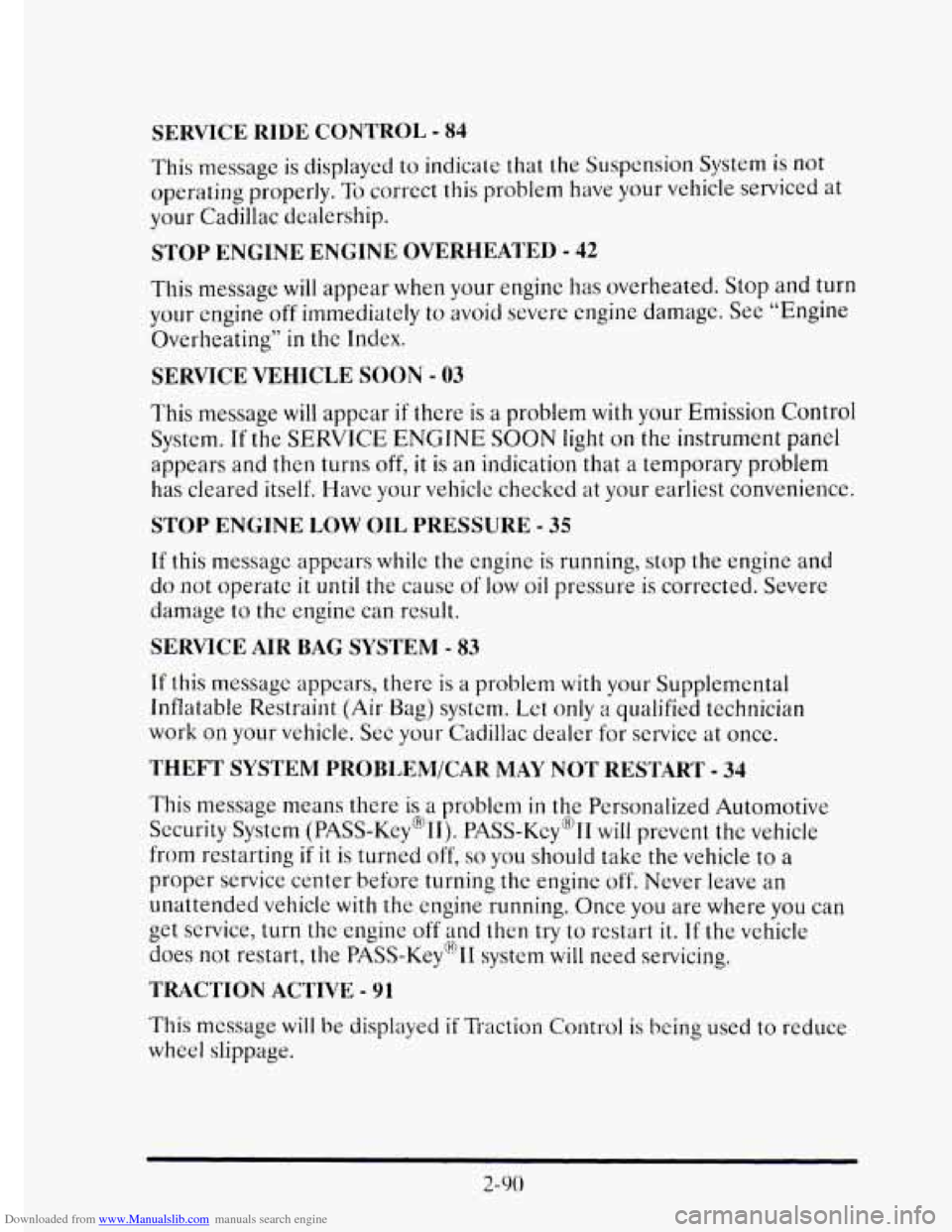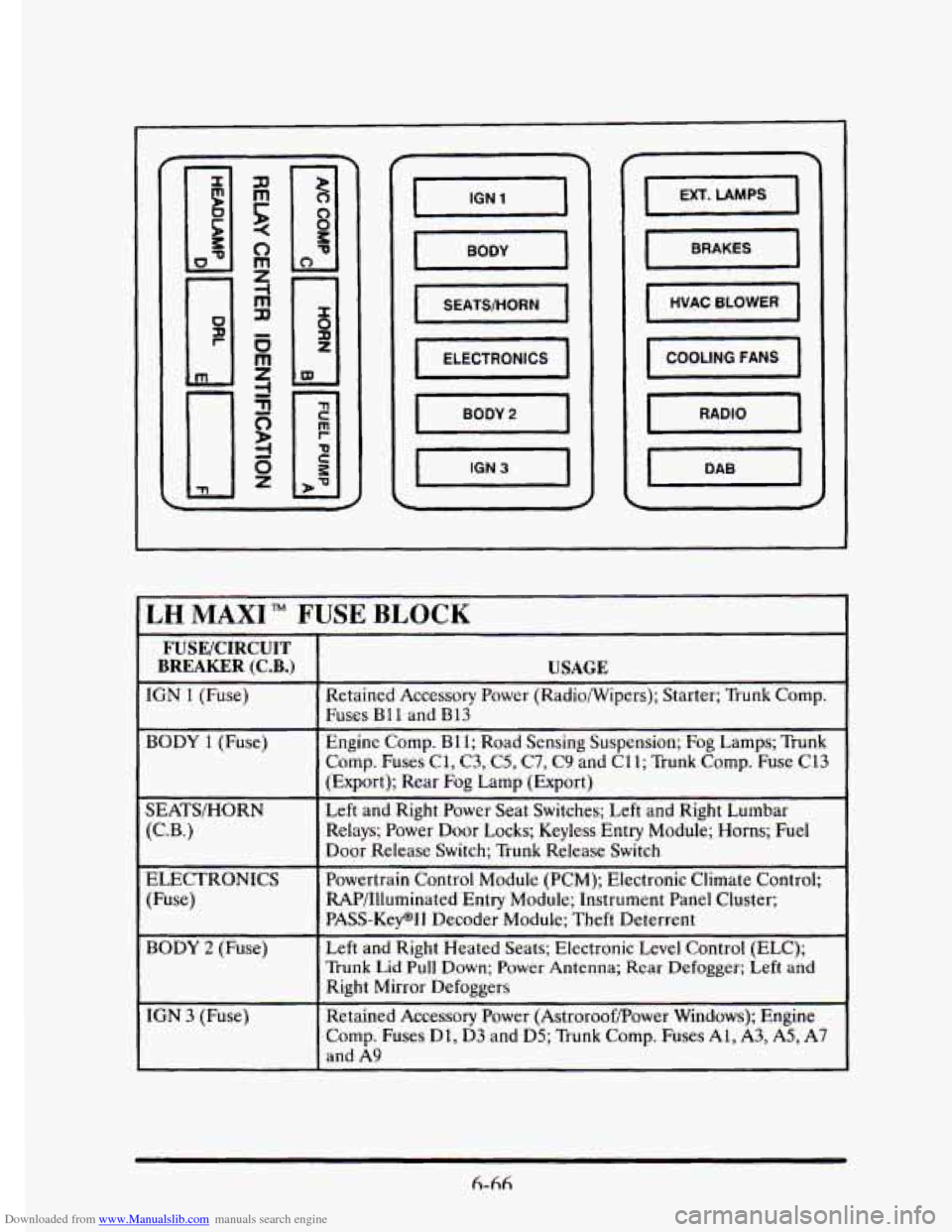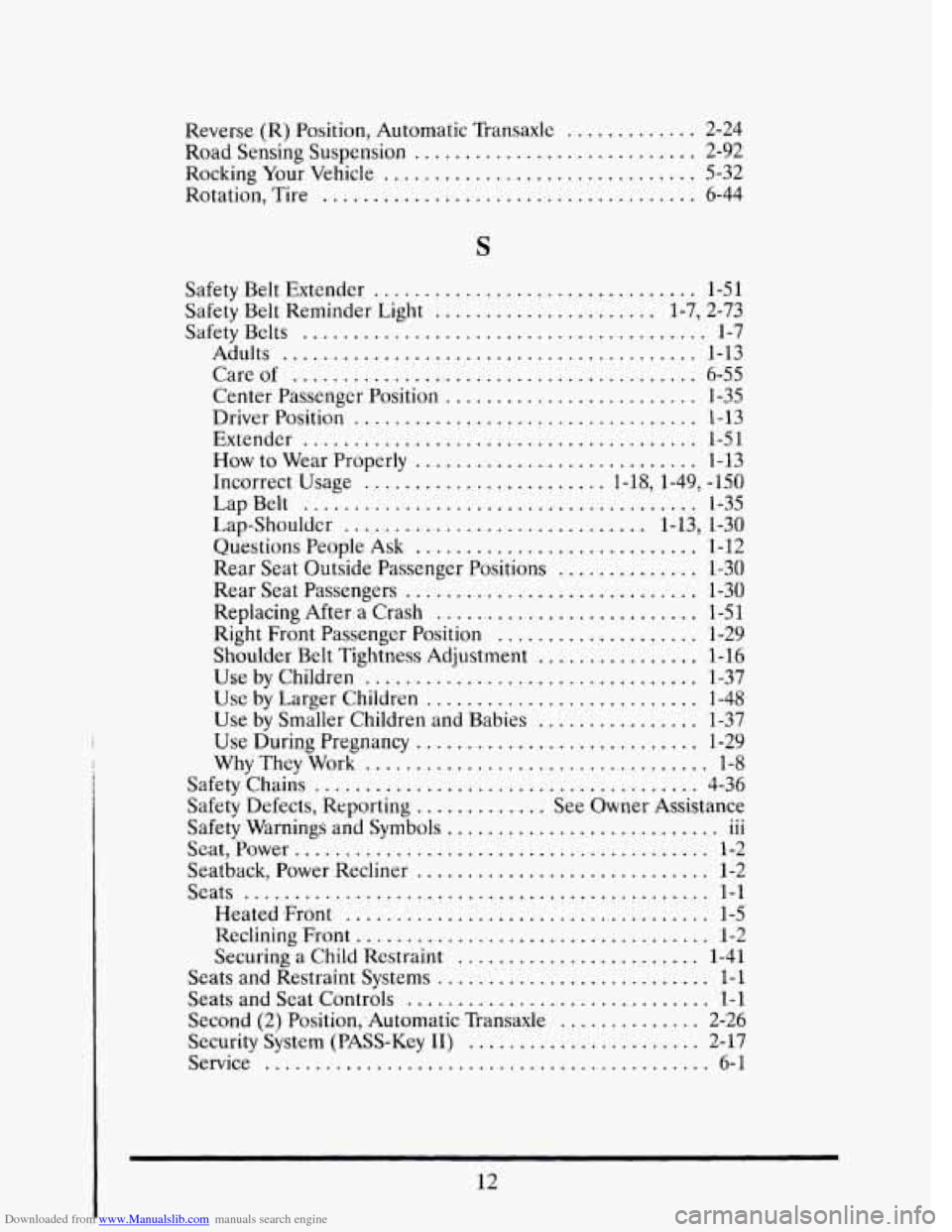1995 CADILLAC ELDORADO suspension
[x] Cancel search: suspensionPage 8 of 395

Downloaded from www.Manualslib.com manuals search engine For the 1948 model. Cadillac
introduced the
which set
the trend in automotive
styling for nearly
two decades. This
was followed by the 1949 model with
the
rwo door hardiop Coupe DeVilIe
and the modern overhead valve,
high co-pression
V8 engine.
Engineering
innervations, con-
veniences and styling dotninated
the
'50s and '60s. Cruise controli auto-
matic climate control,
tiit and
telescoping steering wheels, twilight
sentinel and four door hard tops
all
debuted in these years. In 1957 the
Eldorado Brougham featured
ad-
vances such as air suspension, mem-
ory
seat, automatic electric d.oor
locks, transistor radio, a brushed stainless steel
roof and
low profile
tires.
introduced in
1953, was redesigned for t967 as the
first front wheel drive personal
lux-
ury car. The 472 cu. in. V8 engine
used-
in all Cadillacs in 1968 and
1969 was enlarged to 500 cu. in. for
all 1970 Eldorados.
An
Air Cushion Restraint Sys-
tem (airbag) was available for 1974,
1975 and
1976 Cadillacs.
Analog Electronic Fu.el Injec-
tion was available, on
1975 Cadillacs
and was standard on the new inter-
national size 1976 Sevifle. In
1978,
the Trip Computer option incor-
. porated an on-board microprocessor.
Page 9 of 395

Downloaded from www.Manualslib.com manuals search engine This rich tradition continues
into
the '90s as Cadillac became the
first automobile trnnufacturer to be
awarded the prestigious Malcolm
Baldrige National Quality Award.
The 1992 Seville STS was the
iirst car' ever to win all three major
automotive awards: Car
of the Year,
Motor Trend; Ten Best List, Car ck
Driver; Car of the Year, Automobile
Magazine.
A 1993 Cadillac Ahanti in stock.
technical configuration.
wax selected
as the pace car for the 76th Inilianap-,
dis 500 The demanding pace car
performance and handling require-
menes were mer becausc of such
advances as the Northstar system.
The system includes the 32 valve,
dual ovcrhead camshaft, Northstar
4,.6 liter V8 engine, 4T80 E electroni--
cally controlled automatic transaxle,
road sensing
suspension, speed sen-
sltive steering, antilock brakes and
traction control.
For more than nine decades
Cadillac
has been a leader in quality
and technical innovation. Now more
than ever, substance takes
shape
, is:. -... :. , - .:;: i!
Page 161 of 395

Downloaded from www.Manualslib.com manuals search engine SERVICE RIDE CONTROL - 84
This message is displayed to indicate that the Suspension System is not
operating properly. To correct this problem have
your vehicle serviced at
your Cadillac dealership.
STOP ENGINE ENGINE OVERHEATED - 42
This message will appear when your engine has overheated. Stop and turn
your engine
off immediately to avoid severe engine damage. See “Engine
Overheating”
in the Index.
SERVICE VEHICLE SOON - 03
This message
will appear if there is a problem with your Emission Control
System. If the SERVJCE ENGINE SOON light on the instrument panel
appears and then turns off, it is an indication that a temporary problem
has cleared itself. I-Iavc your vehiclc checked at your earliest convenience.
STOP ENGINE LOW OIL PRESSURE - 35
If this message appears while the cngine is running, stop the engine and
do not operate it until the cause of low oil pressure is corrected. Severe
damage
to the engine can result.
SERVICE AIR BAG SYSTEM - 83
If this message appears, there is a problem with your Supplemental
Inflatable Restraint (Air
Bag) systcm. Let only a qualified technician
work
on your vehicle. See yo& Cadillac dealer for service at once.
THEFT SYSTEM PROBLEM/CAK MAY NOT RESTART - 34
This message means there is a problem in the Personalized Automotive
Security System (PASS-Key@II). PASS-Key@)II
will prevent the vehicle
from restarting
if it is turned off, so you should take the vehicle to a
proper service center before turning the engine off. Never leave an
unattended vehicle
with the engine running. Once you are where you can
get service, turn the engine off
and then tIy to restart it. If the vehicle
does not restart, the PASS-Key(’I1 system
will need servicing.
TRACTION ACTIVE - 91
This mcssage will be displayed if Traction Control is being used to reduce
wheel slippage.
2-90
Page 163 of 395

Downloaded from www.Manualslib.com manuals search engine Road Sensing Suspension
The Road Sensing Suspension (RSS) automatically controls the ride of
your vchicle. The system controls damping forces in the shock absorbers
and struts
in response to various road and driving conditions. The system
is capable of making these changes
within milliseconds.
The Road Sensing Suspension controller is
a computer used to control
and monitor thc system.
The computer receives input from vertical rotary
position sensors, vehicle speed
sensors, lift and dive signals and
determines optimum strut valving (suspension stiffness) for your current
operating conditions. The computer
also receives feedback from the
various components to determine proper system operation.
If the
computer receives
an incorrect feedback from the system, an error code
will be set in memory and a SERVICE RIDE CONTROL message will
display on the Driver Information Center. If this message should appear,
have your vehicle serviccd
at your Cadillac dealership at your earliest
convenience.
Oil Life Indicator
This feature lets you know when to change your engine oil. It's based
upon the engine oil temperatures and your driving patterns.
To see the display press the INFORMATION button several times until
XX OIL LIFE LEFT appears.
You'll see how much
oil life you have
left as
a percentage. So, if you
see 95 OIL LIFE
LEFT, for example,
that means that
the way
you're driving
your car,
95% of your current oil
life
is still left.
2-92
Page 165 of 395

Downloaded from www.Manualslib.com manuals search engine Electronic Level Control
The level control system automatically adjusts the rear trim height in
rcsponse to changes in vehicle loading. The system consists of an air
compressor assembly, air dryer, exhaust solenoid, compressor relay,
height sensor, air adjustable shocks and air tubing.
The height sensing function is performed by the Road-Sensing
Suspension
(RSS) rear position sensors. Rear trim height information is
input from the rear position sensors to the RSS control module which
controls compressor and exhaust solenoid operation.
If the system has a slight leak, the air cornpressor will run frequently for a
few seconds each time.
For a larger air leak the air compressor may stay on for up to seven
minutes.
You should see your dealer for service, but you can keep driving
your Cadillac.
2-94
Page 324 of 395

Downloaded from www.Manualslib.com manuals search engine [Engine Compartment Fuse Block
~~~
E DISTR
USAGE I
INJ
IGN 1
FUEL PUMP
PCM (BAT) RTD (BAT)
F
A/C COMP
HDLPS
TURN/HAZ
DRL
DRL
HTD W/S
IGN OFF
L HDLP
LO
I R HDLP LO Ignition
Control Module
I
L HDLP HI
R HDLP HI
I
I
TRANSECS Sensing
& Diagnostic Module
Powertrain Control Module (PCM); PASS-KeymII Decode llodule
1,4,6 and 7 Fuel Injectors
2,3,5 and 8 Fuel Injectors
A/C Refrigerant Pressure Switch; Transaxle Range Switch;
Stop/BTSI/Cruise Brake Switch; Instrument Panel Cluster; Keyless
Entry Module; DiagnosticEnergy Reserve Module (Derm);
Cornering Lamps; Tbrn/Hazard Switch Assy; Chime Module;
Headlamp Switch; Twilight Sentinel/DRL Module
Fuel Pump; Oil Pressure Switch; Powertrain Control Module
Powertrain Control Module (PCM)
Road Sensing Suspension (RSS) Module
NC Compressor Clutch
Headlamp Dimmer Switch; Headlamp Relay “D” (Engine Comp.
Micro Relay Center); DRL Headlamp Relay
“E’ (with Daytime
Running Lamps); Powers C13
Stop/BTSI/Cruise Switch; Sto lamp Switch Capacitor; Anti-Slip
Regulation (ASR)S Traction 8ontrol
Hazard Flasher; Turn Flasher Relay; Turn Flasher Module
Daytime Running Lamps (Canada)
Left and Right Lo-Beam Headlamp (Canada)
Heated Windshield Control Module
Instrument Panel Cluster
Left Lo-Beam Headlamu
(PCM)
Right Lo-Beam Headlamp
Left Hi-Beam Headlamp
Right Hi-Beam Headlamp
Rear Defogger Relay; Electronic Level Control (ELC); Heated
Windshield; Heater and A/C Programmer; Cruise Control
Extended Travel Brake Switch; Powertrain Control Module (PCM); \
Cooling Fan Relays
1,2 and 3; Front and Rear Heated Oxygen Sensor
Power Steering Pressure Switch; Exhaust Gas Recirculation (EGR)
Valve; Transaxle Shift Solenoids A
& B; Evaporative Emission
Control Solenoid; Powertrain Control Module (PCM); Torque
Converter Clutch Solenoid; TCC Brake Switch
6-65
Page 325 of 395

Downloaded from www.Manualslib.com manuals search engine - -r- -
LH MAXI FUSE BLOCK
FUSE/CIRCUIT
BREAKER (C.B.)
IGN 1 (Fuse)
BODY 1 (Fuse)
SEATSIHORN (C.B.)
ELECTRONICS
(Fuse)
BODY 2 (Fuse)
IGN 3 (Fuse)
USAGE
Retained Accessory Power (Radiowipers); Starter; Trunk Comp.
Fuses
B11 and B13
Engine Comp. B11; Road Sensing Suspension; Fog Lamps; Trunk
Comp. Fuses C1, C3, C5, C7, C9 and C11; Trunk Comp. Fuse C13
(Export); Rear Fog Lamp (Export)
Left and Right Power Seat Switches; Left and Right Lumbar
Relays; Power Door Locks; Keyless Entry Module; Horns; Fuel
Door Release Switch; Trunk Release Switch
Powertrain Control Module
(PCM); Electronic Climate Control;
RAP/llluminated Entry Module; Instrument Panel Cluster;
PASS-KeyW Decoder Module;
Theft Deterrent
Left and Right Heated Seats; Electronic Level Control (ELC);
Trunk Lid Pull Down; Power Antenna; Rear Defogger; Left and
Right Mirror Defoggers
Retained Accessory Power (AstroroofPower Windows); Engine
Comp. Fuses
Dl, D3 and D5; Trunk Comp. Fuses Ai, A3, A5, A7
and A9
6-66
Page 389 of 395

Downloaded from www.Manualslib.com manuals search engine Reverse (R) Position. Automatic Transaxle ............. 2-24
Road Sensing Suspension
............................ 2-92
Rocking Your Vehicle ............................... 5-32
Rotation. Tire
..................................... 6-44
S
Safety Belt Extender ................................ 1-51
Safety Belt Reminder Light
...................... 1.7. 2.73
Safety Belts
........................................ 1-7
Careof
........................................ 6-55
Center Passenger Position
......................... 1-35
Driver Position
.................................. 1-13
Extender
....................................... 1-51
How to Wear Properly ............................ 1-13
Incorrect Usage ........................ 1.18,1.49, -150
Lap Belt
....................................... 1-35
L.a p.Shoulder
.............................. 1.13, 1-30
Questions People Ask
............................ 1-12
Rear Seat Outside Passenger Positions
.............. 1-30
Rear Seat Passengers
............................. 1-30
Replacing After a Crash
.......................... 1-51
Right Front Passenger Position .................... 1-29
Shoulder Belt Tightness Adjustment
................ 1-16
Use by Children ................................. 1-37
Use by Larger Children ........................... 1-48
Use by Smaller Children and Babies
................ 1-37
Use During Pregnancy
............................ 1-29
Why They Work .................................. 1-8
Safety Chains ...................................... 4-36
Safety Defects, Reporting
............. See Owner Assistance
Safety Warnings and Symbols
........................... 111
Seat, Power ......................................... 1-2
Seatback, Power Recliner
............................. 1-2
Seats
.............................................. 1-1
Heated -Front ..................................... 1-5
Reclining Front ................................... 1-2
Securing a Child Restraint
........................ 1-41
Seats and Restraint Systems ........................... 1-1
Seats and Seat Controls .............................. 1-1
Second (2) Position,.Automatic Transaxle .............. 2-26
Security System (PASS-Key 11) ....................... 2-17
Service
............................................ 6-1
Adults ......................................... 1-13
...
12